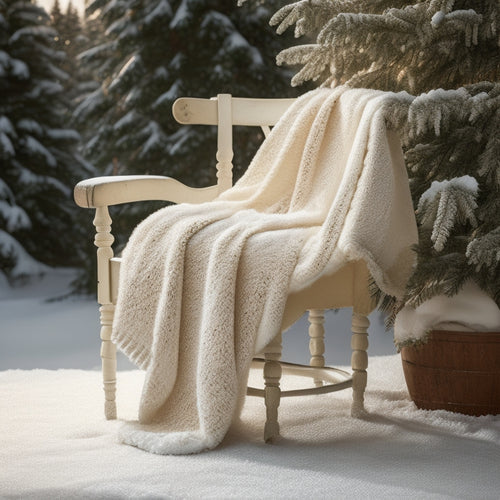
How Far off the Wall Is a Ballet Barre?
Share
You'll typically position a ballet barre 3-4 feet off the wall to guarantee comfortable movement and clearance. This distance guarantees you can move freely and safely, with enough space to stretch and exercise without obstacles. When setting up your barre, consider your height and reach, as well as the room's layout and size. By optimizing your barre's position, you'll be able to focus on technique and movement. Now, get ready to perfect your posture and alignment – there's more to explore to take your practice to the next level.
Key Takeaways
• Leave 3-4 feet of clearance between the barre and obstacles for comfortable movement and safety.
• Position the barre parallel to the mirror for a clear view and optimal alignment.
• Maintain a comfortable distance from fellow dancers to avoid distractions and collisions.
• Adjust the barre distance based on body type variations to ensure a comfortable fit for all users.
• Consider ideal barre distances for different room sizes to optimize space and movement.
Measuring Up: Understanding Barre Height
Stand in front of a ballet barre and you'll quickly realize that its height is essential, as it needs to support your arm at a 90-degree angle, with your elbow relaxed and your forearm parallel to the floor. Meeting Barre Standards requires attention to Height Variations, as a barre that's too high or too low can compromise your form and put unnecessary strain on your body.
Ideally, your barre should be adjustable, accommodating dancers of different heights and needs. With a range of Height Variations, you can find the perfect fit, ensuring you can focus on perfecting your technique rather than struggling with an ill-fitting barre.
The Importance of Barre Placement
As you've mastered the ideal barre height, you'll want to strategically position it to facilitate effortless movement and proper alignment, considering the floor space, mirrors, and surrounding environment to optimize your practice. Proper barre placement is important for a liberating dance experience. It's vital to respect barre etiquette, making sure there's a comfortable distance from the wall and adequate space for movements. This consideration will enhance your dance psychology, allowing you to focus on technique rather than spatial constraints.
Here are some key considerations for ideal barre placement:
-
Leave enough space: Ensure at least 3-4 feet of clearance between the barre and any obstacles, including walls, mirrors, or other dancers.
-
Face the mirror: Position the barre parallel to the mirror, allowing for a clear view of your movements and alignment.
-
Consider the floor: Place the barre on a non-slip surface, and avoid areas with heavy foot traffic or distractions.
- Respect personal space: Maintain a comfortable distance from fellow dancers, promoting a sense of freedom and focus.
Factors Affecting Barre Distance
As you consider the ideal barre distance, you'll want to take into account how your body type influences your stance and movement.
You'll also need to factor in the room's size and layout, which can greatly impact your barre placement.
Body Type Variations
Your body type noticeably influences the ideal distance from the wall, with taller dancers typically requiring a shorter barre distance to maintain proper alignment and prevent strain.
As you consider your body type, keep in mind the following factors:
-
Petite frames: You may need a shorter barre distance to accommodate your smaller stature and maintain proper alignment.
-
Curvy silhouettes: A slightly longer barre distance can provide more comfort and support for your figure.
-
Longer limbs: You may require a shorter barre distance to avoid straining your muscles and joints.
- Athletic builds: A longer barre distance can help you maintain proper alignment and generate more power in your movements.
Room Size Constraints
You'll need to adapt your barre distance to the room's dimensions, as a cramped space may require a shorter distance to avoid feeling claustrophobic or restricted in your movements. Consider the room's furniture layout and optimize the space to guarantee a comfortable and effective workout.
| Room Size | Ideal Barre Distance |
|---|---|
| Small (100-150 sq ft) | 24-30 inches |
| Medium (150-250 sq ft) | 30-36 inches |
| Large (250+ sq ft) | 36-42 inches |
Room Size and Layout Considerations
When designing a ballet studio, take into account the room's dimensions and layout to guarantee a safe and effective workout space, with a minimum of 10 square feet per dancer and 12 feet of clearance between the barre and any obstacles. This will make sure you have ample space to move freely and comfortably.
Consider the following layout tips:
-
Optimize corner spaces: Use wall-mounted barres or install mirrors to make the most of these areas.
-
Arrange furniture thoughtfully: Place benches, chairs, and other furniture in a way that promotes easy movement and minimizes obstacles.
-
Leave space for circulation: Ensure there's enough room for dancers to move around each other and the barre.
- Consider a 'dance zone': Designate a specific area for dancing, keeping it clear of clutter and tripping hazards.
Dancer Height and Reach Factors
As you design your ballet studio, take into account the height and reach of your dancers to guarantee the barre is positioned at a comfortable and effective height for everyone.
Consider the flexibility limitations of your dancers, as well as their body proportions. A barre that's too high or too low can compromise proper alignment and technique.
For taller dancers, a higher barre may be necessary, while shorter dancers may require a lower setting.
When determining the ideal barre height, factor in the average height and reach of your dancers.
Barre Style and Material Considerations
When choosing a ballet barre, it's important to evaluate the frame material. Will a sturdy wood or durable metal frame suit your needs?
You'll also need to determine between a horizontal or vertical design. This decision should take into account the available wall space and your personal preference.
Additionally, think about whether adjustable height options are essential for your training or teaching requirements.
Wood or Metal Frame
You'll find that ballet barres typically come in two primary frame styles: wood and metal, each with its own set of advantages and disadvantages that can greatly impact your dance experience.
When choosing between wood and metal frames, consider the following factors:
-
Aesthetics: Wood frames often feature a natural wood grain, adding warmth to your dance space.
-
Durability: Metal frames are known for their durability and can withstand heavy use.
-
Maintenance: Wood frames may require periodic polishing, while metal frames are often low-maintenance.
- Cost: Metal frames can be more budget-friendly, while wood frames may be a greater investment.
Horizontal or Vertical
Two primary barre styles exist: horizontal and vertical, each with distinct advantages that can greatly impact your ballet practice and overall dance experience. As you consider your options, think about the space you're working with and your personal preferences.
Horizontal bars, often wall-mounted, provide excellent support and stability, making them ideal for beginners or those who need extra assistance.
Vertical bars, typically floor-standing, offer greater flexibility and movement freedom, making them perfect for more advanced dancers or those who prefer a more dynamic practice.
Consider your goals, the type of exercises you'll be doing, and the space you have available. By choosing the right barre style, you'll be able to focus on perfecting your technique and enjoying the freedom of movement that ballet offers.
Adjustable Height Options
Having already explored the horizontal or vertical orientation of your ballet barre, now contemplate how an adjustable height option can further personalize your practice to your needs. This feature is especially valuable for dancers who share a barre with others or need to accommodate different exercises. With an adjustable height option, you can easily switch between settings to optimize your practice.
Here are some benefits to ponder:
-
Portability benefits: Adjustable height options often come with lightweight and compact designs, making them easy to transport and store.
-
Customization trends: Dancers can experiment with different heights to find the perfect fit for their bodies and exercises.
-
Space-saving design: Adjustable barres can be easily stowed away when not in use, ideal for small studios or homes.
- Injury prevention: By adjusting the height to a comfortable level, dancers can reduce strain on their joints and muscles.
Safety and Ergonomic Concerns
Maintaining proper posture and alignment is essential when using a ballet barre to prevent straining your muscles and joints, as poor ergonomics can lead to injuries and long-term damage.
You want to make sure you're holding yourself upright, with shoulders relaxed and engaged core. This posture awareness is key to injury prevention, as it allows you to move efficiently and safely.
When you're mindful of your body position, you can focus on your movements and technique, rather than worrying about discomfort or pain. By prioritizing proper alignment, you'll be able to move freely and confidently, enjoying the full benefits of your ballet barre workout.
Setting Up for Optimal Use
You'll get the most out of your ballet barre workout by positioning the barre at a comfortable height, allowing your arms to relax and your elbows to bend at a 90-degree angle. This proper alignment is key to enjoying a safe and effective workout.
To achieve ideal positioning, follow these guidelines:
-
Stand with your feet shoulder-width apart, facing the barre directly.
-
Keep your shoulders relaxed and down, avoiding tension in your neck and shoulders.
-
Engage your core to support your posture and maintain balance.
- Adjust the barre height to fit your individual needs, ensuring your elbows can bend at a 90-degree angle.
Frequently Asked Questions
Can I Install a Ballet Barre on a Carpeted Floor?
As you ponder installing a ballet barre on your carpeted floor, remember to secure a Carpet Grip system to prevent Floor Damage, ensuring a sturdy setup that frees you to pirouette with confidence and creativity.
What Is the Ideal Barre Height for Children or Beginners?
When setting up a ballet barre for kids or beginners, you'll want to make barre adjustments based on age guidelines: for 3-5 year olds, it's 24-28 inches, while 6-10 year olds use 28-32 inches, and 11+ year olds use 32-36 inches, ensuring a comfortable fit for freedom of movement.
Can I Use a Wall-Mounted Barre in a Rented Space?
As you begin your ballet journey, you're constrained by rent restrictions and lease limitations, but don't let that hold you back - consider a removable wall-mounted barre that leaves no trace, giving you the freedom to dance.
How Do I Secure a Free-Standing Barre From Tipping Over?
You'll secure your free-standing barre by ensuring proper weight distribution and using floor anchors to prevent tipping, giving you the freedom to focus on your dance moves, not worrying about stability.
Are There Any Benefits to Using a Portable Ballet Barre?
You'll appreciate the benefits of a portable ballet barre, such as space efficiency, allowing you to practice anywhere, and injury prevention, as it provides support and stability, giving you the freedom to focus on perfecting your technique.
Related Posts
-

7 Essential Training Secrets for Dance Makeup Artists
You're about to discover the secrets to transforming your dance makeup artistry into a thriving online business, wher...
-

Winter Dance Blanket: Perfect Super Bulky Knit
The Winter Dance Blanket is a delightful super bulky knit pattern designed for effortless creation, featuring a simpl...
-

Color Your World: Dance Pages Galore
Color Your World: Dance Pages Galore is a wide-ranging platform offering a diverse range of dance-inspired coloring p...


